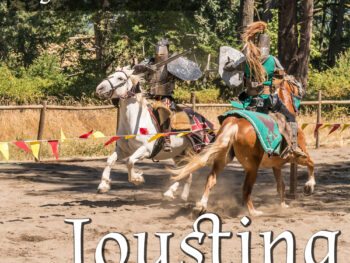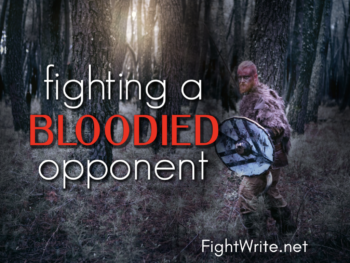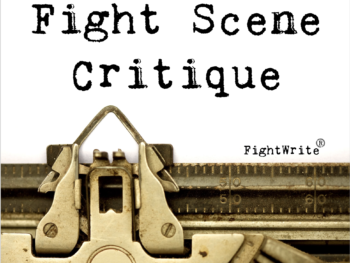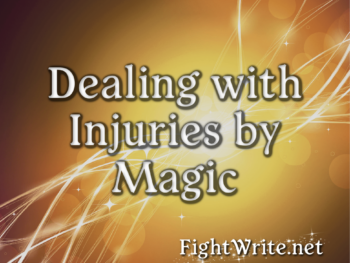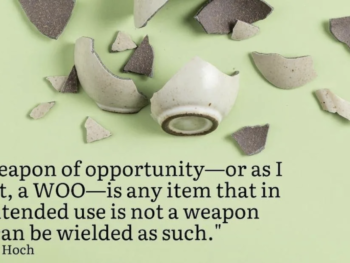I have a regular post on the Writer’s Digest Blog writing fight scenes!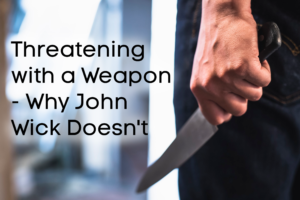 (Imagine that!) In my most recent post, I made a statement about threatening with a weapon which caused a wee bit of a stir on the social media:
(Imagine that!) In my most recent post, I made a statement about threatening with a weapon which caused a wee bit of a stir on the social media:
Our characters should never use a knife simply to intimidate because the presence of a blade immediately ups the stakes. What might have been a fistfight, where a few punches are thrown then everyone goes home, would become a fight to spare one’s life. That’s a very different “why” for fighting. And, if you’ve read my previous posts, you know when you change the “why” of a fight, you change the fighter. So, as far as our characters brandishing a blade, if they show, they better go.
The stir was about using a weapon to intimidate. Some writers felt it was fine to do and could be productive in making an assailant back off. I understand that thinking. And, just because one shouldn’t do something, doesn’t mean they won’t. I shouldn’t have used the word “never” in the blog post. Like I always say, “never use absolutes!”
There will be times that a character will intimidate with a weapon. And, if you as a writer think that character should brandish a weapon, by all means, write it. However, be aware of the possible consequences of threatening with a weapon:
The stakes will go up.
What might have been a shouting match or posturing may become something quite different in the presence of a weapon. Yes, the menacing character may back off. But, they may not. If your character threatens with a weapon, they must be ready for the latter and willing to take action. If they are not willing to use the weapon they brandish, they may cower in the face of of opposition and drop or have it taken from them. That ain’t good. That weapon becomes a liability rather than a safeguard. And, let’s not forget, the villain just might have a weapon too. They might have been fine to keep it hidden. But, with the stakes raised, they will make use of it.
The legal implications will change.
In my book there is an entire chapter on the legal ramifications of self defense. When a person feels that their life is in danger, they have the right, in most states, to defend in themselves. However, it’s not just a matter of what a character sees as “reasonable self defense.” Ultimately, “reasonable” is whatever a jury sees as reasonable which may be vastly different than what your character thinks. Most self defense laws contain the following formula: 1) There must be a reasonable belief that one is in 2) imminent danger of unlawful force or deadly force, and 3) authorization to use the corresponding amount of force to defend oneself. If a villain approaches your character in a dark parking lot and simply creeps a character out and that creeped out character draws a knife, they have broken the law. If they proceed to injure the villain, they may be found guilty of assault with a deadly weapon. If that injury is mortal, your well meaning character may be convicted of murder. That said, be sure to the check the laws of your area of setting. In Texas, you can kill an intruder to your home. California not so much. In England if you shoot an intruder, you will be going to jail for not only murder/attempted murder but for having a gun at all.
A real example.
I was in a self defense situation and brandished a knife on someone. Yes, really. I was terrified and honestly didn’t realize what I was doing. It was a gut reaction. I held the knife up and pointed it at the man’s face. He looked at the knife, looked me in the eyes, then backed away. In retrospect, I’m not sure what I would have done with the knife. This was decades ago, long before I was involved in any sort of training.
If he had advanced, I do believe I would have stabbed him but only one time. He was larger than me and would have overcome me before I had a chance to strike more than once. In order to stop him with one strike I would have had to go for the jugular – which I don’t think I would have done. It’s funny how even in a life or death situation we consider the grossness of spurting blood. Or, I would have had to go for the abdominal aorta – which I wasn’t aware of at the time. Or, I would have needed to stab him in the heart – which I couldn’t have done with the knife I had in my hand. It wasn’t sharp enough to get through the ribs.
So, to your point, writers, yeah, sometimes threatening with a weapon works. That doesn’t make it the smartest course of action.
Why Wick doesn’t threaten with a weapon
Ok, now to John Wick. Roll it… Oh, wait. Can we just all look at Common for a second? That’s the actor we see here. He is just a pretty man. (looking, looking…) Ok, NOW, hit play!
Now, if you have seen the Wick movies, you know Jardani (his birth name) will kill a fool. He is an excellent shot. And, during this concert, he has already done some killing. There is blood splatter on his face. He sees Cassian before Cassian sees him but doesn’t address Cassian. We can only assume Wick hopes Cassian doesn’t see him and there is good reason for that. Wick has done some damage to someone Cassian is hired to protect. Wick knows that when Cassian finds out what he has done, Cassian will come for him.
As soon as Cassian addresses him, John knows he is in danger. He could absolutely brandish a gun to intimidate Cassian. Maybe Cassian would back down. There would be no escalation, the two would slowly back away and John could safely exit without drawing attention. Seems like a no brainer. So, why doesn’t Wick pull a gun to intimidate?
Because there’s a %99.9 chance Cassian won’t back down and that %.01 chance that he might isn’t worth the risk. If Wick moves to draw a gun – even to just intimidate – his counterpart will draw and fire. The same holds true for Cassian. So, the two stand there, waiting for each to make the first move. Normally, action is faster than reaction. But in the case of these two, trained as they are, the difference in speed is negligible.
When John Wick pulls a gun, he’s willing to use it for whatever reason he pulled it. That really is the smartest course of action. You can’t bet on the intimidation working. If you hesitate to use the weapon you have shown, it could be a mortal liability.
So, what about your character? They aren’t John Wick. Should they, despite everything written in this post, draw a weapon to intimidate? Well, should isn’t the same as would. Yes, they might draw a weapon to intimidate. It happens all the time in the real world – I mean, heck, I did it. It’s a bit of a trope in movies, generally involving a woman. She pulls the gun and aims, her hands shaking. The villain raises his hands and smiles, knowing the woman likely doesn’t have the guts to do it. Sometimes he backs away slowly. Sometimes he takes the gun from her and makes her look like a fool. But, sometimes, to the shock of them both, she shoots.
If you remember nothing else
Your character should not draw a weapon they aren’t willing to use.
If your character draws a weapon just to intimidate: the stakes go up, the law comes down, and the whole thing can go sideways.
All that said, your character might draw a weapon they aren’t willing to use just to intimidate. They are, after all, human and we humans do a lot of things we ain’t ‘sposed to do.
Until the next round at FightWrite™.net, get blood on your pages!
I’m going to go watch all the Wicks again…




